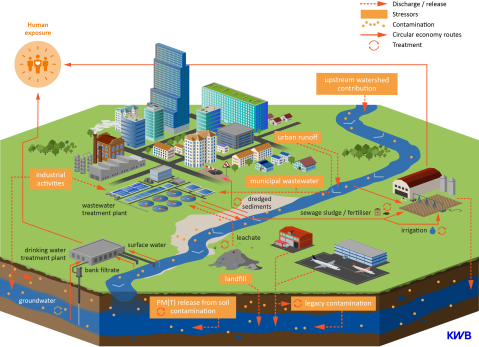Circular Economy Routes
The Work Packages and Case studies aim to identify critical issues and potential solutions for monitoring and remediating industrial Mobile, Perstistent and potentially Toxic chemicals (iPM(T)s) in five different circular economy routes in the soil-sediment-water system:
Drinking water is produced by treating raw water, which can be a combination of groundwater and surface water, in drinking water treatment plants before distribution to consumers. After using the water, the resulting wastewater is transported via the sewer system to wastewater treatment plants. There, it is treated physically, chemically and biologically. Only then the wastewater can be discharged to rivers or other surface water bodies. Finally, drinking water treatment plants can pump surface water through various soil layers – known as bank filtration – to supplement the raw water needed to produce new drinking water. Such a semi-closed water cycle not only recycles water but may also transfer chemicals, such as PFAS or iPM(T)s, to water consumers.
Two Case Studies in PROMISCES are addressing this CE route
In areas where surface water or groundwater quantities are lacking, treated municipal or industrial wastewater can be reused to irrigate farmland. Treated wastewater is currently discharged into surface waters, but it can also undergo additional treatment and be directly used for irrigation. PROMISCES will investigate combined electrochemical and wetlands treatment for the removal of PFAS and iPM(T)s. Knowledge gained on the water-to-crop transfer of compounds will provide vital information on potential human health risks associated with direct or indirect (e.g. animal fodder) crop consumption and agricultural best practices for farmers.
One Case Study in PROMISCES is addressing this CE route
Reusing what was once considered waste is an integral part of a circular economy. To enable safe resource reuse in the form of fertilizers produced from sewage sludge, PROMISCES will study the efficiency of PFAS and iPM(T) removal during landfill leachate treatment. Testing new treatment technologies and combinations will bring us closer to the goal of near-zero pollution discharge from landfill leachate treatment plants. Certain innovative treatments will also allow energy recovery (e.g. gas). Ultimately, this will lead to better prevention of PFAS transfer into fertilizer products. This is critical because as soon as the fertilizer is applied, its constituents end up in the crops, soil and groundwater.
One Case Study in PROMISCES is addressing this CE route
In these times of increasing urbanization, construction demands are constantly rising. But construction material does not necessarily need to be new, and materials derived from waste products can often be reused. This is the case with dredged sediment, which is extracted during the expansion and maintenance of harbours or shipping channels. Once properly treated and freed from harmful substances, including PFAS and iPM(T)s, these sediments can be reused as ecological and sustainable building materials, for example in the construction of dams, embankments or roads.
One Case Study in PROMISCES is addressing this CE route
The water cycle is fragile and must be protected. Groundwater is particularly important – not only for drinking water supply, but for the environment as a whole. To protect the water cycle, both groundwater and the soil through which rain water infiltrates into groundwater are regularly monitored. Should either media become contaminated with PFAS and iPM(T)s due to chemical pollution from human activities via landfills, industrial discharges or brownfields, quick and effective remediation is vital to preserve environmental and human health.
Two Case Studies in PROMISCES are addressing this CE route

